|
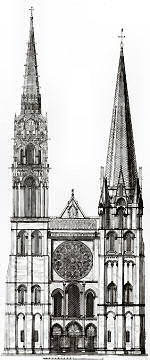 |

|
Cathedrals 11a:
the buttresses and roof of Chartres |
|
|
|
|
|
|
|
|
The vast curtain walls of Chartres cathedral are supported by great stone flying buttresses, while the vert-de-gris [verdegris] copper roof is supported by an enormous iron framework not usually seen, a relatively modern wonder of engineering.
This page is an appreciation of technology and engineering past that still endures.
the buttressing of chartres
Buttresses support the the weight of roof and walls, preventing the walls from collapsing outwards under the weight. With the walls no longer being the only load-bearing part of the cathedral's structure, vast openings could be made and filled with stained glass.
Here, abelard focuses on the exterior buttressing. The buttressing marches along each side of the nave, and reach like arched fingers, providing support around the apse.
To ensure the entrance of daylight and the visibility of the windows, the buttresses were built so they would minimise shading or obscuring the windows. The buttressing of Chartres cathedral is an example demonstration of this technique.
side buttressing
Just below are photographs of the cathedral's south side. The face-on picture below left]shows how the buttresses are placed between the windows rather than across them, while the side view [below right]shows how the buttresses bulk is reduced to minimise shadows and to allow more light to enter through the windows.
The letters A, B, C, D match the same buttresses on the face-on and side views.
There are statues in niches on the end of each buttress.
A full cross-section of the side buttressing for the north side is shown in the line drawing to the right.
Notice that the buttressing is not the same as that on the south side.
On the north side, the pillars are columns with Tuscan capitals, but there are no cut-outs [see right].
On the south side, the pillars are simple bars, while there are cut-outs in the arch above the pillars [see below]. |
related pages :
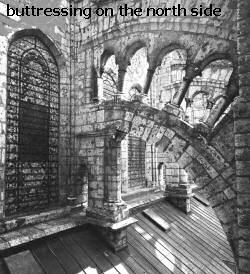
|
|
The left-hand photo just above also illustrates where the different types of stained glass windows are located within the nave of cathedral. Windows such as Saints Christopher and Nicaise and Saints Laumer and Mary of Egypt are on the upper level of glass, while story windows of the lives of saints such as Saint Thomas à Becket and other worthies like Charlemagne, and educational windows, say the zodiac and people’s labours, are on the lower level. This makes them easier for the congregation to see and study.
apsidal buttressing
Around the aspe, the apsidal buttressing is an elegant succession of arched buttresses, with the walls of many decoratively cut like doilies. They march around each of the "interior roof spaces" (see roof level plan below). |
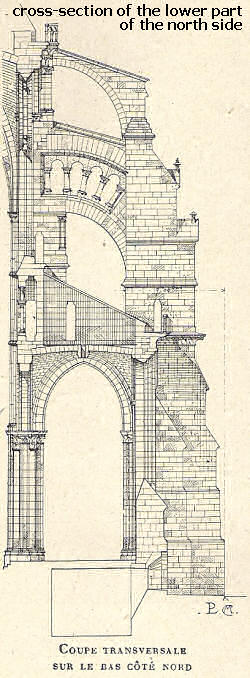 |
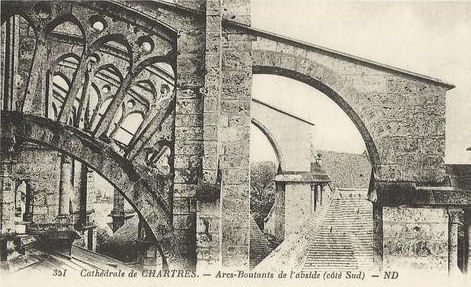 |
Left: Old postcard showing the apsidal flying buttresses.
Below left: Ground-level view from south-east, showing how the buttressing is placed each side of the windows, like sun-rays.
Below
right: Ground-level view from south. |
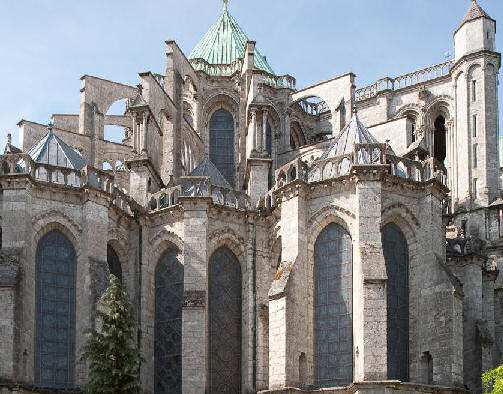 |
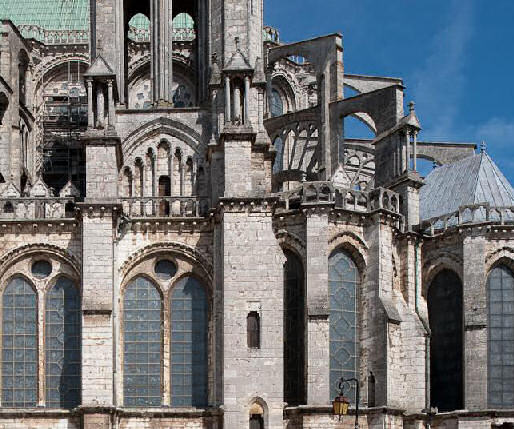 |
|
roof space : le charpente de fer
- charpente :
- French for structure, framework
- de fer :
- French for 'of iron'
On June 4, 1836, following the carelessness of plumbers who were making repairs, a fire broke out in the roofing timbers. The fire spread quickly, destroying the wood frame, the forest, and the lead roof of Chartres cathedral. Fortunately, the fire did not advance into the bell tower. There, the great bell was not harmed, sounding for half an hour. Many lower bells were lost, to be replaced in 1840 and 1845 by those still rung today.
The roof was replaced by a beautiful iron frame and a copper roof, built in metal for future safety and for economy like the partial roof at Southwark Cathedral, London built during the restoration of 1822-25,[1] and the cupola at Mayence [Mainz in Germany], built in 1827 (?).[2] When built, the span over the cathedral's crossing (where the nave crosses the transept) was the largest of any iron-framed construction in Europe. The iron frame looks like a huge boat overturned. The framing has joists of wrought and cast iron, connected by rafters that ensure the rigidity of the structure. During the winter storm in 1997, a portion of the roof was torn and was long covered by tarpaulins. By December 2009, renovations were completed. The metal frame, having suffered from corrosion and expansion due to temperature changes, has been partially restored between 1995 and 1997 by Guy Nicot, chief architect of historical monuments.
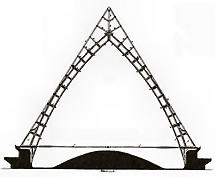 The roof structure of Chartres cathedral is one of the oldest iron structures in France. It was built in 1837 by architect Emile Martin and locksmith Mignon. The structure was made combining wrought iron and cast iron. The principal curved beams rising to meet at a point, are cast iron. They support a superstructure in iron carrying the roof of copper tiles. The iron horizontal rafters are connected by several rows of double spacers, forming a very rigid system. The system of segments bolted together and crossed by cast iron bars is inspired by some iron bridges built in England, such as the Severn Bridge at Coalbrookdale, built in 1777. On such constructions, the resistance of cast iron in compression enables the creation of arches. The steep slope of the rafters limits the bending forces, while a series of wrought iron rods take up a portion of the lateral thrust. The roof structure of Chartres cathedral is one of the oldest iron structures in France. It was built in 1837 by architect Emile Martin and locksmith Mignon. The structure was made combining wrought iron and cast iron. The principal curved beams rising to meet at a point, are cast iron. They support a superstructure in iron carrying the roof of copper tiles. The iron horizontal rafters are connected by several rows of double spacers, forming a very rigid system. The system of segments bolted together and crossed by cast iron bars is inspired by some iron bridges built in England, such as the Severn Bridge at Coalbrookdale, built in 1777. On such constructions, the resistance of cast iron in compression enables the creation of arches. The steep slope of the rafters limits the bending forces, while a series of wrought iron rods take up a portion of the lateral thrust. |
related pages :
|
plans of Chatres cathedral
On these plans the buttressing, both along the sides of the nave and around the apse, have been highlighted.
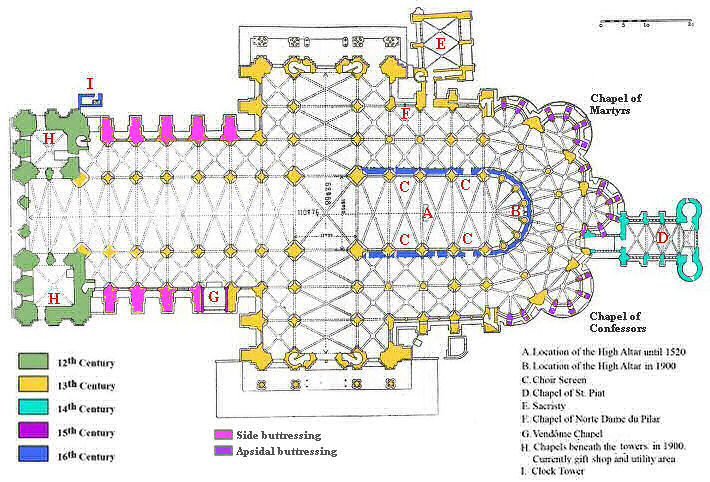
Floor plan of the Cathedral de Notre Dame de Chartres
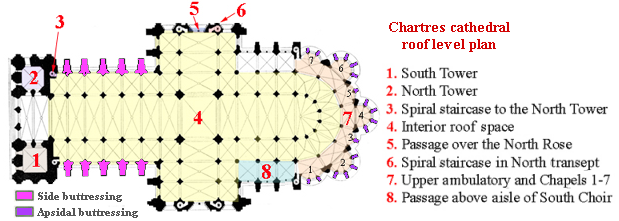
Plan of upper (roof) level
|
| Background facts |
Chartres 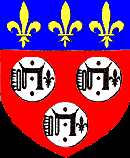 |
approximate population : 39,160
average altitude/elevation : 140 m
Chartres is in département 28, Eure-et-Loir.
- cathedral dimensions
- overall length : 130 m / 430 ft
overall width : 32 m / 105 ft
nave, length : 73 m
transept width : 46 m / 151 ft
width of nave : 16.4 m / 54 ft
height of nave : 37 m / 121 ft
diameter, large rose : 13.4 m
width, west front : 47.5 m
height, south-west tower: 105 m / 144 ft
height, north-west tower: 113 m / 371 ft
ground area: 10,875 sq. m / 117,060 sq f
|

bibliography

|
Guide to Chartres cathedral
Editions Houvet-La Crypte, Chartres, pbk, 1990
ASIN: B000XD411S
amazon.com
amazon.co.uk |
This is almost a telephone directory of the stained glass and statuary (statues) of the cathedral. The book has been around in various versions for most of a hundred years. Thus it is cheap and easy to obtain.
 |
|
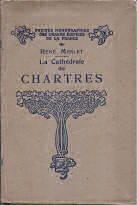 |
La Cathédrale de Chartres
by René Merlet
Henri Laurens, Paris, pbk, approx. 1900s
(series: Petites monographies des grands édifices de la France) |

|
English Heritage Research Transactions Vol 7: Timber: Dating of the Roof
Timbers at Lincoln Cathedral by Jeanne Marie Teutonico, R.R. Laxton, C.D. Litton, and R.E. Howard
£33.25 [amazon.co.uk] {advert}
amazon.com [amazon.com]
James & James (Science Publishers) Ltd; Volume 7, 2001, pbk
ISBN-10: 1902916034
ISBN-13: 978-1902916033
A short, 80-page introduction for enthusiasts.  |
|
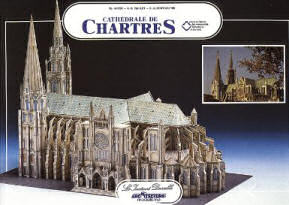
Base: 13.5" x 24"/35 x 61 cm, height: 17.5"/44cm
96-page paperback book with 35 pages of heavy card printed in colour, to cut out and make into 1/250th scale model.
Text in French with English, German, Spanish, Italian, Japanese translations included.
Note that the French publisher, L'Instant Durable, appears to only sell its publications through online outlets such as amazon. |
Cathédrale de Chartres
by Thierry Hatot, Anne-Marie Piaulet, Bernard de Montgolfier
L'Instant Durable/Paper Models International, 1990
- ISBN-10: 2864040425
ISBN-13: 978-2864040422
amazon.com from $74
amazon.co.uk from £74
|
end notes
- It is often assumed by those knowing some French that charpente is derived from char-pente,where pente means slope.
However, charpent comes from the Latin word carpentum, a two-wheeled chariot.
In Gaulois, charpente described a chariot, a small cart, made of an assembly of bits of wood.
The word charpente comes from the Mérovingien Latin, carpenta, a piece of wood.
[Etymological leads thanks to DVH.]
- The iron roof was above the choir. It was built by George Gwilt Jr., 1785-1856.
- The cupola was removed in 1870 because it was too heavy. Other early examples of ironwork usage were St. Isaac's cathedral in St. Petersburg, Russia, and the leaning tower of Nevyansk, Russia. The latter was probably built a hundred years earlier. However, these two were also only cupolas.
- char (d'assaut) nm.
- in modern French, a (miltary) tank.
An associated word is charabanc, from the French char-à-banc, a cart or wagon with benches on/in it, much used in England between the wars [1920s to 30s] - an open-roofed coach, most often carrying holiday-makers.
|
related pages :

|










